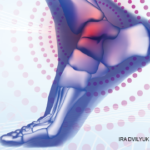The researchers also noted that plantar fasciitis was more common in the shod group than the barefoot group. Additionally, shod runners experienced more patellofemoral pain syndrome and ITBS than did barefoot runners. Dr. Altman-Singles describes this difference as huge. Although barefoot running may have offered some protection against plantar fasciitis, barefoot runners had a greater number of Achilles or calf and posterior tibialis strains when compared with shod runners. Dr. Altman-Singles explains the findings by noting that, “What we do know is that barefoot running results in a lower loading rate.”
Turner Vosseller, MD, assistant professor of foot and ankle surgery at Columbia University Medical Center in New York, agrees. “What there is, is a lot of objective evidence that when you run barefoot, you run differently,” he explains in an interview with The Rheumatologist. Instead of striking with the heel, barefoot runners tend to land on their forefoot. The barefoot runners also take shorter strides, which also leads to less heel impact and less force transmitted through the body.
What to Tell Patients?
In the 1970s, shoe companies, such as Nike, began to put more cushioning into shoes. Runners adapted to these shoes by running more on their heels. More recently, shoe companies have created footwear that is designed to mimic barefoot running and the new research raises the question: Should patients be counseled to try barefoot running?
“I think it definitely can be helpful,” responds Dr. Altman-Singles. “What we can say is that it may help you to avoid certain types of injuries.” She also emphasizes that the study was designed to evaluate full barefoot running, and the results cannot necessarily be extrapolated to minimal footwear. However, she notes that minimal footwear would likely help to protect the feet from abrasions, a problem that is common with true barefoot running.
It’s likely that some foot types do better with barefoot running and others do better with shod running. The mechanical difference between barefoot running and shod running does mean, however, that individuals who switch from barefoot running to shod running should slowly transition to allow their bodies to adapt to the different mechanical forces.
“This is really good work in one sense: This is something that a lot of people are interested in,” notes Dr. Vosseller.
“Their results are about what I would expect them to be,” he explains, noting that there are inherent limitations in the study design, specifically the use of a survey. Nevertheless, “I think as a first step, it is a good idea,” he adds, explaining that the authors did a good job of translating the science into a clinical setting.
